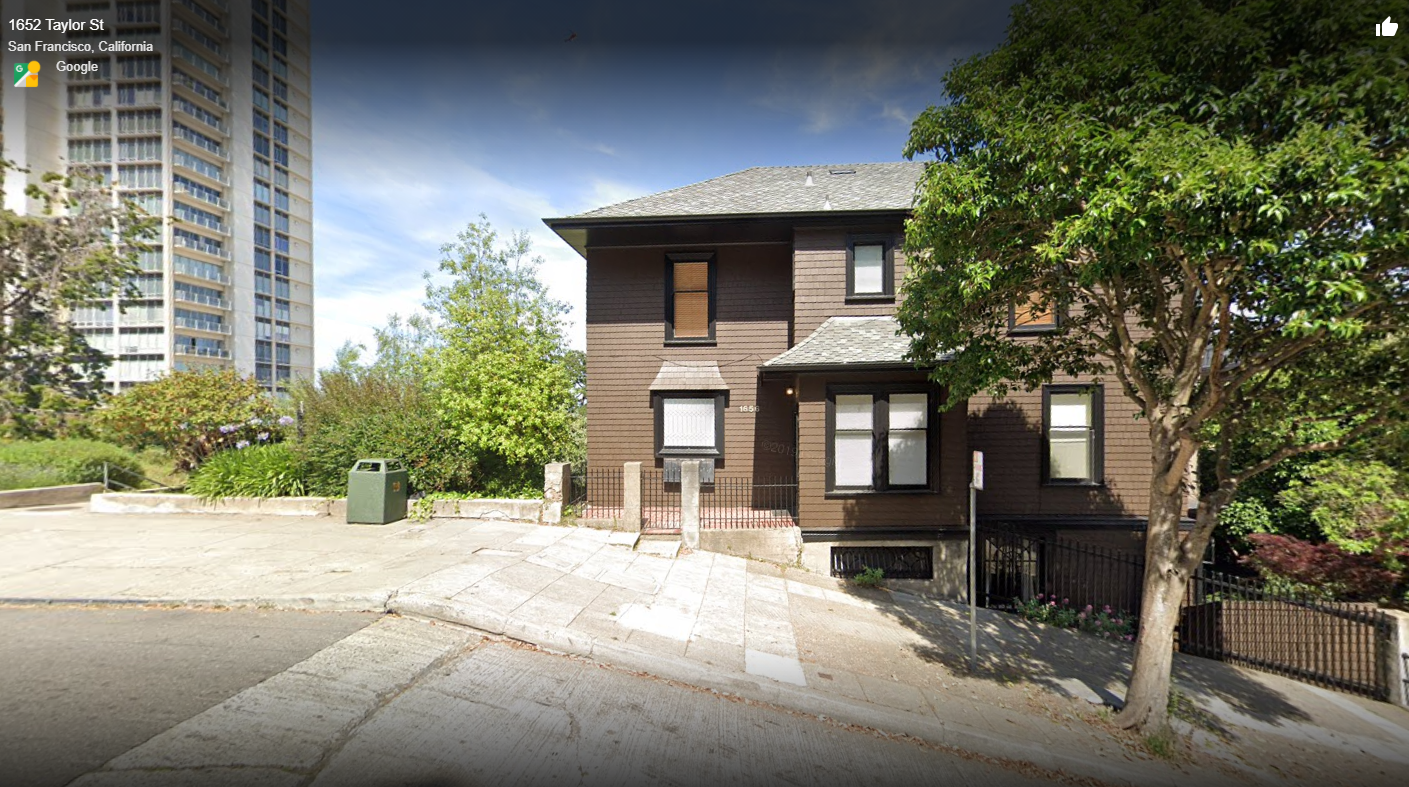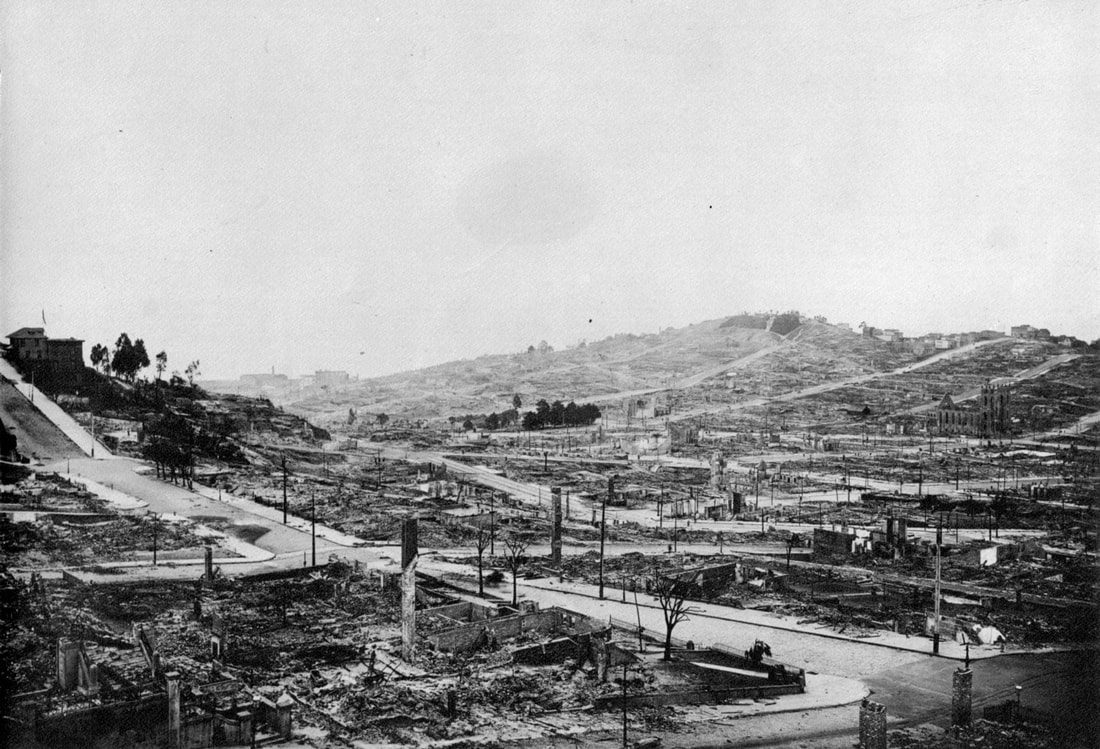|
This view from Nob Hill looking up Taylor at Jackson to Vallejo Street - is half a block from the summit of Russian Hill. The true summit lies at Vallejo between Taylor and Jones. Also seen here are the cross streets of Pacific Avenue and Broadway. Ina Coolbrith Park is located just across the Vallejo stairs from the house seen in the upper left corner - The House of the Flag. Today the 225 step Vallejo Stairs are on both sides of Taylor Street. The House of the Flag is on the SE corner of the Vallejo stairs and Taylor Street. It was named a San Francisco landmark in 1972 and has become part of the lore of this special neighborhood which was home to a coterie of the most creative and interesting San Franciscans of their time. It also largely survived the fire and has many pre-earthquake buildings still standing watch from the top of Russian Hill.  The House of the Flags on Taylor Street now! The House of the Flags on Taylor Street now! According to Russian Hill legend, the house, like its neighbors on the hillside which commanded a clear view of the Bay, was built by a sea captain who framed the house with Georgia Pine brought around the Horn. The house, clinging to the brow of the cliff, dates from around 1860. In 1903, the owner Eli T. Sheppard added a new portion on the uphill side. The new portion was then rented to Edward A. Dakin, a Civil War veteran and active Grand Army of the Republic* (GAR) member. Dakin, a printer and publisher, collected historic flags, and his collection included flags from U.S. Warships which had seen service in the Spanish American War: the "Marblehead"; the famed "Oregon", built in the Union Iron Works, San Francisco; and the "Olympia" flagship of Commodore Dewey at Manila Bay. Sheppard, like Dakin a Civil War veteran, had served 1869 to 1875 as U.S. Consul in Tientsin, China. A lawyer, he had been appointed in 1876 by President U.S. Grant, as adviser in international law to the Imperial Japanese cabinet, and he later returned to San Francisco to practice law. Sheppard’s portion of the house was filled with treasures which he had brought back: presentation swords, vases, lacquer cabinets and others, gifts from the Emperor and Empress of Japan and from Princes of the Royal Household. The principal historical distinction of the house lies in its dramatic rescue during the 1906 disaster. According to an account in St. Nicholas Illustrated Magazine of July 1908 (oral accounts differ in minor details): When the Earthquake struck Mrs. Brindley, Sheppard's daughter, knew from her experience in the Orient that the water supply was likely to be cut. She filled all the tubs with water before the mains broke, and additionally went to the nearby grocery and bought siphon bottles of "fizz" water. However, the size of the fire storm was unexpected, and the Sheppard family left when the eaves and veranda caught fire. Dakin however remained. Dakin decided upon a spectacular end for the house. It should go down in flames with flags flying. He went to the room where he kept his flag collection, chose the largest, and hoisted it on the pole on the roof. He dipped the flag three times in salute, descended, the stairs, closed and locked the door. His gesture did not go unnoticed. Three blocks downhill, at the corner of Vallejo Street and Montgomery (now Columbus) Avenue, a newly arrived company of the 20th Infantry Regiment saw the flag salute, and one remarked, "Boys, a house that flies a flag like that is worth saving". The young officer in command gave the order, and the company was up on the hill on the double. Arriving at the house they tore off the burning wood, broke open the door, entered and saw the tubs of water. The soldiers mixed earth with the water to the consistency of wet plaster, applying it to the burning wood and smothering the flames. As they worked, all the other houses along Taylor Street burned, but this house stood. Still the fire burned on, and found a lodging place under the eaves. The soldiers could not reach it from the windows. Mounting to the roof, men leaned over the roof, held by their comrades, who passed the siphon bottles. The man at the point of the line squirted them into the flames, extinguishing the last embers, and the house was saved. The owners and tenants having crossed by ferry to Oakland, supposed their house destroyed like the others. Not until several days after the Fire did they see a newspaper with a photograph of the house still standing, flag flying, and learned that, like the Horatio Livermore houses and others on the crest of the hill above, their house had been saved. From that time on the "House of the Flag" has been a living legend in the neighborhood. It appears in many views taken from the slopes above, as one of the few survivors of the days when "the Earth Shook and the Sky Burned". (1972 SF CITY PLANNING COMMISSION RESOLUTION NO. 6809) Marguerite Brindleys personal story is also recorded at the Online Archives of California: "Papa managed to hire a carriage to drive us to the bottom of our hill on Taylor St. I wish I could make you see by words, what I saw on that drive. Not a single unburnt house! The roads heaped with bricks, broken glass, half burnt furniture, and a network of broken wires. I can never tell you my feelings when we came in sight of our house standing on the top of the hill, with its flag, at half mast, and absolutely unharmed. All the houses that has [sic] stood around it burnt to their foundations. It gave me a feeling almost of awe. It seemed as though it must have been some higher power that had intervened to save it. There are about ten houses on the crest of the hill at the back saved, and beyond and in all directions, everything is burned." Eli Sheppard shortly thereafter sold the house to Bruce Porter, painter, poet, editor, sculptor and Bohemian bon-vivant. Porter in turn commissioned his good friend architect Willis Polk to remodel it. Willis changed the entire structure while preserving its rustic appearance. In 1892 with his father Willis Webb and brother Daniel, Willis designed and built 1017 and 1019 Vallejo which appears to be one home but were originally two townhomes. The Polk Family lived in 1017 and Mrs. Virgil Williams lived in 1019. Daisy Polk and her parents left in 1906, like many others, to their home in the East Bay Hills and rented the Vallejo home. Daniel had since moved to New York and Willis was living in Pacific Heights at the time of the earthquake. Willis was responsible for a number of structures on Russian Hill including Upper and Lower Vallejo Steps Gardens and Stairway designed to replace a goat hill, The Vallejo Crest Turnaround (said to be the original San Francisco gallows location), 1, 3, 5, 7 Russian Hill Place, and the The Balustrade at Jones and Vallejo. *GAR was a fraternal organization composed of veterans of the Union Army (United States Army), Union Navy (U.S. Navy), Marines and the U.S. Revenue Cutter Service who served in the American Civil War.
1 Comment
Jim Prunetti
9/12/2020 09:28:58 pm
The second photo is post earthquake and fire...
Reply
Your comment will be posted after it is approved.
Leave a Reply. |
Some stories that couldn't make the book in full ... but need to be told! Editors welcomed - sign up below.
STORIES
WR HEARST PLANS SONG: DAISY HOT SPRINGS 1882 A WILLIS POLK GIFT THE RLS CONNECTION 1896 EARTHQUAKE TALES FROM COPPA PANDEMIC OF 1889 THE BOMB THAT SHOOK SF MILAN:CITY OF WATER POLK ON THE MAP FEATHERS, FASHION & FLY FISHING RARE AVIATION FILM - WWI 1914-17 1906 SAN FRANCISCO WTF FILES - TECHNOLOGICAL GET ME OUTTA HERE! NO HORSES, NO TENTS, NO $ DAISY IN FRENCH LITERATURE DAISY ON FILM! THE WHITE DEATH THE SYMBOLISM OF FLOWERS POSTE DE SECOURS WWI TRAVEL 1900: LONDON TO PARIS DAISY: REST IN PEACE KEITH'S, DRANE'S & KENTUCKY MOTHER: MISSOURI COMPROMISE Topics
All
|


 RSS Feed
RSS Feed